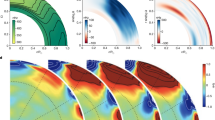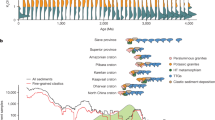Abstract
Reliable measurements of both ocean floor topography and heat flow indicate a linear dependence on the square root of the age, t, of the ocean floor for t ≲90 Myr (ref. 1) or about half the age of the large oceanic plates. Consequently, major topographic and heat flow variations perpendicular to mid-ocean ridge axes are generally believed to be thermally induced and associated with contraction of the lithosphere as it moves away from the ridges1–4. For t>90 Myr, measurements of bathymetry (but not of heat flow) indicate a systematic departure from a t½ relationship reaching almost 20% at the oldest ages. We present here numerical calculations of thermally induced topography above two-dimensional convection cells which are heated partially from within and partially from below. These exhibit the same general features as oceanic bathymetry and we suggest that departures of the latter from a t½ dependence may be due to radiogenic heating within the mantle.
This is a preview of subscription content, access via your institution
Access options
Subscribe to this journal
Receive 51 print issues and online access
$199.00 per year
only $3.90 per issue
Buy this article
- Purchase on Springer Link
- Instant access to full article PDF
Prices may be subject to local taxes which are calculated during checkout
Similar content being viewed by others
References
Parsons, B. & Sclater, J. G. J. geophys. Res. 82, 803–827 (1977).
Parsons, B. & McKenzie, D. P. J. geophys. Res. 83, 4485–4496 (1978).
McKenzie, D. P. J. geophys. Res. 72, 6261–6273 (1967).
Sclater, J. G. & Francheteau, J. Geophys. J. R. astr. Soc. 20, 509–542 (1970).
Turcotte, D. L. & Oxburgh, E. R. J. Fluid Mech. 28, 29–42 (1967).
Turcotte, D. L. & Oxburgh, E. R. Ann. Rev. Fluid Mech. 4, 33–68 (1972).
Robinson, J. L. J. Fluid Mech. 30, 577–600 (1967).
Roberts, G. O. Geophys. Astrophys. Fluid Dynamics 12, 235–272 (1979).
Olson, P. & Corcos, G. M. Geophys. J. R. astr. Soc. (in the press).
McKenzie, D. P., Roberts, J. M. & Weiss, N. O. J. Fluid Mech. 62, 465–538 (1974).
Jarvis, G. T. & McKenzie, D. P. J. Fluid Mech. 96, 515–583 (1980).
Oxburgh, E. R. & Turcotte, D. L. Rep. Prog. Phys. 41, 1249–1312 (1978).
Hess, H. H. in Petrologic Studies: A Volume in Honor of A. F. Buddington (eds Engel, A. E. J., James, H. L. & Leonard, B. F.,) 599–620 (Geological Society of America, 1962).
McKenzie, D. P. Geophys. J. R. astr. Soc. 48, 211–238 (1977).
Peltier, W. R. in Physics of the Earth's Interior (eds Dziewonski, A. & Boschi, E.) (Academic, New York, 1980).
Author information
Authors and Affiliations
Rights and permissions
About this article
Cite this article
Jarvis, G., Peltier, W. Oceanic bathymetry profiles flattened by radiogenic heating in a convecting mantle. Nature 285, 649–651 (1980). https://doi.org/10.1038/285649a0
Received:
Accepted:
Issue Date:
DOI: https://doi.org/10.1038/285649a0
This article is cited by
-
Fractal density and singularity analysis of heat flow over ocean ridges
Scientific Reports (2016)
-
Fractal reconstruction of sea-floor topography
Pure and Applied Geophysics PAGEOPH (1989)
Comments
By submitting a comment you agree to abide by our Terms and Community Guidelines. If you find something abusive or that does not comply with our terms or guidelines please flag it as inappropriate.



